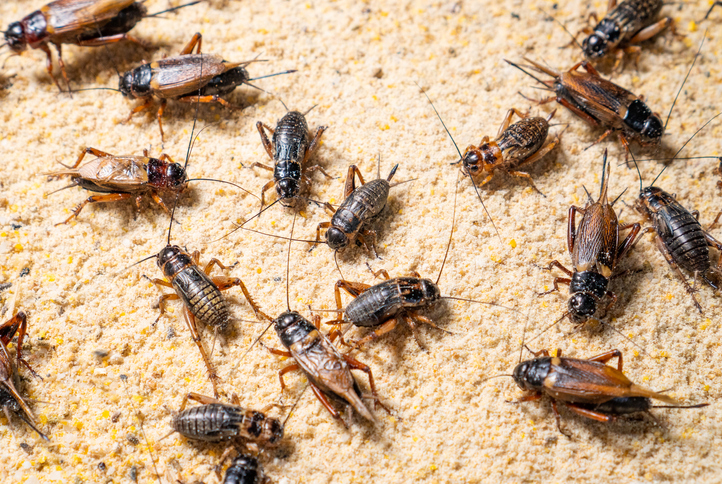Cricket Infestation Control
How to Control a Cricket Infestation
To control a cricket infestation, start by sealing entry points in your home, such as cracks and gaps around doors and windows. Reduce moisture by fixing leaks and using dehumidifiers, as crickets thrive in damp environments. Regular cleaning helps eliminate potential food sources. For immediate control, use diatomaceous earth, sticky traps, or insecticide sprays. For persistent or severe infestations, professional pest control services like Orkin can provide tailored and effective solutions. Regular maintenance and preventive measures are key to keeping your home cricket-free.
Your Guide to a Cricket-Free Home
Crickets, while seemingly harmless, can be a real nuisance in your home. These chirping critters not only disrupt your peace with their incessant noise but can also cause damage to fabrics, papers, and even walls. Knowing how to tackle a cricket infestation effectively is crucial in maintaining a comfortable and safe home environment.
Identifying the Intruders
When it comes to controlling a cricket infestation, the first crucial step is identifying the intruders. Crickets come in various species, each with unique characteristics and habits. Understanding these differences is essential in determining the most effective control strategy.

Save $50
on your first recurring service today with code GET50
Common Cricket Species
- House Crickets – The most familiar in residential areas, house crickets are light yellowish-brown with three dark bands across their heads. They are about 3/4 to 7/8 inch long. These crickets are attracted to warm, moist environments, making homes an ideal habitat, especially during colder months.
- Field Crickets – Larger and darker than house crickets, field crickets are black or dark brown and are typically found outdoors. However, they can venture indoors in search of food.
- Camel Crickets – Known for their humpbacked appearance, camel crickets are light to dark brown with a rounded body. They don’t chirp like other cricket species and are often found in damp basements or crawl spaces.
- Mole Crickets – These crickets have a unique, mole-like appearance with specialized front legs for digging. They primarily live underground and are more of a concern for garden and lawn damage.

GET A PERSONALIZED QUOTE
To protect your home from pests, click here for a free pest control estimate. Our Orkin Pros will create a personalized pest treatment plan for your home or business
or Call (866) 249-0292
Identifying Features and Behaviors
- Chirping Sounds – One of the most distinctive features of crickets is their chirping sound, primarily produced by male house and field crickets. This chirping is a mating call and is more prevalent at night.
- Physical Appearance – Crickets generally have long antennae, robust hind legs for jumping, and wings. The size, color, and wing length can vary significantly between species.
- Habitat Preferences – While house crickets prefer warm indoor environments, field and mole crickets are more commonly found outdoors. Camel crickets are drawn to damp, dark spaces.
Specific Treatments to Control Crickets
To effectively eliminate crickets from your home, a variety of specific treatments can be employed, tailored to the type of cricket infestation. Insecticide sprays and baits are particularly effective against house and field crickets; these can be applied around the home’s perimeter, focusing on entry points such as doors, windows, and foundation cracks. For camel and mole crickets, which prefer damp environments, spraying insecticides in basements, crawl spaces, and around the home’s exterior is advisable. Additionally, for mole crickets that damage lawns and gardens, applying granular insecticides to the soil can be an effective solution.
Glue boards and sticky traps are useful for indoor cricket control, trapping crickets that have entered your living spaces. These should be strategically placed in corners, along walls, and near potential entry points. Another safe and natural option is diatomaceous earth, a powder that dehydrates crickets upon contact, which can be sprinkled in areas where crickets are prevalent.
Reducing attractants is also a key part of cricket control. This involves removing food sources by keeping the home clean and free of food debris and spills, and eliminating moisture by fixing leaky faucets and pipes, and using dehumidifiers in damp areas. Exclusion techniques such as sealing cracks and openings in the home’s structure and installing door sweeps on exterior doors are also effective in preventing crickets from entering.
In cases of severe infestations or persistent cricket problems, professional pest control services, such as those provided by Orkin, are recommended. Our experts are equipped to identify the specific cricket species infesting your home and develop a tailored treatment plan. This plan may include advanced insecticides and long-term prevention strategies, ensuring a comprehensive solution to your cricket problem. Remember, Orkin is always ready to assist with expert advice and effective solutions for all your pest control needs.
Orkin’s Expert Solutions
At Orkin, we understand the frustration of a cricket infestation. Our trained professionals use a combination of techniques tailored to your specific situation.
- Inspection and Identification – Our experts will inspect your home, identify the cricket species, and determine the source of the infestation.
- Customized Treatment Plans – Based on the inspection, we’ll create a treatment plan that may include baits, sprays, and exclusion techniques.
- Follow-Up and Prevention – We’ll provide tips for ongoing prevention and offer follow-up treatments if necessary.
When to Call Orkin
If you’ve tried DIY methods and still face a cricket problem, it’s time to call in the experts. Orkin’s professionals are equipped to handle severe infestations effectively and safely.
At Orkin, we’re committed to providing top-notch pest control services. Our team is trained to handle a variety of pest problems, including crickets. Trust us to keep your home cricket-free.
Frequently Asked Questions
What are the common signs of a cricket infestation?
Common signs include the sound of chirping (especially at night), visible sightings of crickets in your home, and evidence of damage such as chewed fabrics, papers, or plants.
Why are crickets attracted to my home?
Crickets are drawn to warm, moist environments. They often enter homes seeking shelter and food, especially during colder or dryer seasons.
How can I prevent crickets from entering my home?
To prevent crickets from entering, seal cracks and openings in your home’s exterior, reduce moisture by fixing leaks and using dehumidifiers, and keep your home clean to remove potential food sources.
What are some effective DIY methods for cricket control?
DIY methods include using diatomaceous earth, setting up glue boards or sticky traps, and applying natural repellents like essential oils. Regular cleaning and decluttering also help in reducing cricket infestations.
When should I call a professional for cricket control?
If DIY methods are ineffective or if you are dealing with a large or persistent cricket infestation, it’s advisable to call a professional pest control service like Orkin for a more comprehensive solution.
Can crickets cause damage to my lawn or garden?
Certain species, like mole crickets, can cause damage to lawns and gardens by burrowing and feeding on plant roots. If you notice unusual lawn damage, it might be due to a mole cricket infestation.
Are cricket control treatments safe for pets and children?
Most modern pest control treatments are designed to be safe around pets and children when used as directed. However, it’s important to follow all safety instructions and consider consulting a professional for advice.
How long does it take to get rid of a cricket infestation?
The time it takes to control a cricket infestation can vary depending on the severity of the infestation and the methods used. Some solutions provide immediate relief, while others, like baiting, may take longer to fully eradicate the problem.
Conclusion
Controlling a cricket infestation in your home requires a multifaceted approach that includes identification, prevention, and targeted treatment. Understanding the specific type of cricket you are dealing with is crucial, as different species have varying behaviors and preferences. Implementing preventive measures such as sealing entry points, reducing moisture, and maintaining cleanliness can significantly reduce the likelihood of an infestation.

FIND YOUR LOCAL BRANCH
To protect your home from pests, click here for a free pest control estimate. Our Orkin Pros will create a personalized pest treatment plan for your home or business
or Call (866) 249-0292

